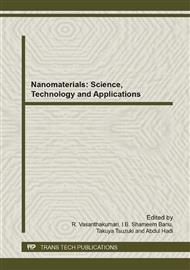p.269
p.275
p.280
p.286
p.292
p.299
p.305
p.311
p.316
Nano Gold Doped Nano TiO2 – An Efficient Solar Photocatalyst for the Degradation of Persistent Organic Pollutants
Abstract:
Novel nanogold doped TiO2 nanoparticles are found to be highly efficient for the photocatalytic degradation of organic pollutants. TiO2 nanoparticles were synthesized from titanium (IV) isopropoxide through hydrothermal route. Gold nanoparticles were prepared by chemical reduction and stabilization employing D-glucosamine, and were doped in TiO2 nanoparticles. The analysis revealed that the diameter of gold nanoparticles used for doping is around 5 nm. Undoped and gold doped samples were characterized by X-ray diffraction (XRD), Raman spectroscopy, UV-Vis diffuse reflectance spectra (DRS) and field emission scanning electron microscopy (SEM). DRS study showed that nanogold doping in titania nanoparticles induces a shift of absorption edge to the visible range and reduces the band gap. Complementing our earlier finding that noble metal doping in titania nanoparticles enable photocatalytic activity in the visible region, it is showed that gold doping enhances photocatalytic activity of the titania nanoparticles. This was confirmed by the degradation of the dye methylene blue repeatedly using gold doped nanoparticles under direct sunlight. Further, the nanoparticles were used to study the degradation of the persistent organic pollutant, β endosulfan, and near complete degradation were observed in an hour. Regenerated nanoparticles were found effective for the degradation of the pesticide for more than three cycles.
Info:
Periodical:
Pages:
292-296
Citation:
Online since:
June 2014
Authors:
Price:
Сopyright:
© 2014 Trans Tech Publications Ltd. All Rights Reserved
Share:
Citation:


